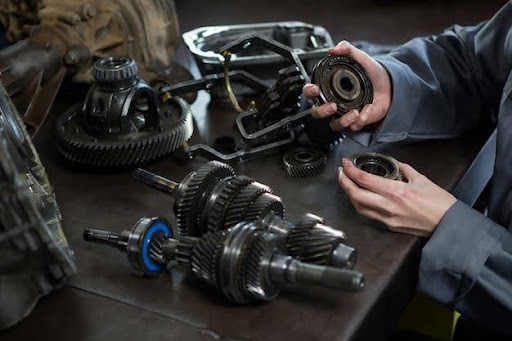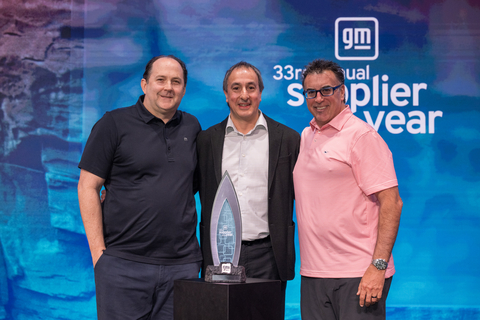
 As part of a $3 billion effort to become General Motors’ lower cost answer to Lexus, Buick is putting new focus on finely crafted interiors and overall refinement. The first model to showcase these qualities is Buick’s 2005 LaCrosse sedan, which takes the place of the Regal and Century this fall. The 2001 appointment of GM Vice Chairman Bob Lutz during the development of the LaCrosse led to a delay, while the design was revised and higher goals set for the car.
As part of a $3 billion effort to become General Motors’ lower cost answer to Lexus, Buick is putting new focus on finely crafted interiors and overall refinement. The first model to showcase these qualities is Buick’s 2005 LaCrosse sedan, which takes the place of the Regal and Century this fall. The 2001 appointment of GM Vice Chairman Bob Lutz during the development of the LaCrosse led to a delay, while the design was revised and higher goals set for the car.
As a consequence, the design and engineering team improved fit and finish and tightened tolerances outside and inside the LaCrosse, as well as reducing unwanted noise in the cabin and refining drivetrain and suspension characteristics.
Though LaCrosse, built at GM’s Oshawa, Canada, plant, carries over GM’s front-drive W-body architecture (in parallel with the new Pontiac Grand Prix), it sees major upgrades in terms of hardware, from engines to chassis componentry. The overriding purpose, says Judy Brennan, LaCrosse vehicle line director, is to reassert the once-held notion that seeing a Buick in someone’s driveway meant that householder had ‘made it.’
“LaCrosse is a very important model for Buick,” adds Mark D. Hines, marketing director for Buick’s midsize cars. “Not only does it set the stage for renewal of our entire car line, but it replaces two models — Regal and Century — that account for almost half of Buick car sales.
LaCrosse represents four key attributes that Buick will continue to emphasize: smooth power, elegant design, expertly crafted interiors and a comfortable yet responsive ride.”
From an engineering perspective that directive has meant an unprecedented concentration on reducing panel gaps. On the exterior the new standard for Buick is 3 mm, while inside the gaps are one mm or less. For example the gap between the handle escutcheon and the surrounding trim panel is 0.25 mm. Inside, the LaCrosse instrument panel surfaces are low gloss, with attractive graining, chrome and woodgrain accents and soft-touch plastic or paint feel in most areas. “Chrome is making a comeback,” says LaCrosse designer, Dennis Burke. “We have bright metal finishes inside and out.”
The center stack climate and audio controls are modern looking, cleanly laid out and nearly flush with the panel. LaCrosse has more rear legroom than previous midsize Buicks, thanks to a 1.5-in. increase in wheelbase. Front and rear hip room is also increased.
The interior is configured for either five or six passengers. Five-passenger versions have a wide center armrest with deep storage area and console-mounted gearshift lever. Six-passenger models feature a “flip and fold” seatback cushion that can be converted into a center console/armrest with a large storage bin. The shift lever in six-passenger models is mounted on the steering column.
“For those who need the extra passenger space, LaCrosse’s six-passenger configuration is another significant competitive advantage over the import competition,” says Hines.
 |
| Special attention has been given to LaCrosse’s interior. Low gloss surfaces and attractive graining, chrome and woodgrain accents add to the aura of elegance. Interior gaps have been reduced to 1 mm or less. An optional 240 hp 3.6L VVT V-6 finds its way under LaCrosse’s hood courtesy of the Cadillac CTS sedan. This is the first transverse-mounted use of this powerplant. |
 |
Along with interior refinement, the LaCrosse development team promises the car will be extraordinarily quiet, possibly one of the quietest vehicles in GM’s stable. Dubbed ‘QuietTuning,’ the team approach to noise and vibration reduction was all-encompassing and can be seen in new measures throughout the vehicle.
One of the more unusual measures is the use of a Helmholzt resonator, a specially designed chamber aimed at controlling exhaust noise. The resonator was not inexpensive and posed packaging challenges in a tight engine bay, acknowledges Chief Engineer Ed Hufnagle. As well as the resonator, the extensive series of sound dampening measures include:
- Acoustical laminate on windshield and front side glass.
- Quiet Steel laminate on the front-of-dash body area.
- Expanded baffles in the roof pillars to block noise paths.
- Extensive use of melt-on sound deadener throughout the entire lower body structure.
- A sound-absorbing interior carpet backing and additional headliner pad coverage (using Collins & Aikman’s ‘ACT fiber absorption carpet).
- Specifically designed acoustical engine covers and revised exhaust tuning to reduce high frequency noise.
- A hood insulator pad.
- A sound-absorbing layer under the instrument panel top pad and rear parcel shelf.
Not surprisingly, applying these measures, especially the laminated glass on front side windows and the sound-absorbing carpet backing was an expensive and challenging undertaking.
Part of the effort to reduce noise sources concentrated on the powertrains, which were substantially revised for the LaCrosse application. The uplevel engine option is GM’s recently launched all-aluminum engine 3.6L VVT (variable valve timing) V-6.
Previously offered in the rear-drive Cadillac CTS sedan, this V-6, with 240 hp and 230 lb.ft. of torque, makes its first U.S. front-drive, transverse mounting appearance in the LaCrosse. With dual overhead camshafts, four-valves-per-cylinder and fully variable intake and exhaust valve timing, the engine is very flexible, delivering 90 percent of peak torque between 1,600 rpm and 6,000 rpm. “It torque peak arrives at 2,000 rpm,” says premium V-6 engineer Bob Jacques, “it’s a very tractable engine.”
Adds Tim Cyrus, global V-6 chief engineer for GM Powertrain: “It delivers impressive power across a wide range of driving conditions, while being extremely smooth and quiet.” The addition of the Helmholzt resonator to the VVT V-6 lowered energy in the exhaust system and helped the muffler engineers, says Hufnagle.
The standard LaCrosse engine is GM’s venerable 3800 V-6, with 200 hp and 225 lb.ft. of torque. This engine receives many significant upgrades including upgrades is an electronic throttle control, which improves engine response and fuel efficiency while reducing complexity, as well as structural upgrades for quieter operation.
These structural changes include a cast aluminum oil pan and a transmission brace to reduce powertrain bending, acknowledged as one of the engine’s weaknesses. Overall, the new 3800 engine is 30 percent quieter than its predecessor and it is also one of the first V-6 motors to meet SULEV emissions requirements.
Along with interior and powertrain refinements, the LaCrosse also sees extensive revisions to its chassis and suspension to produce a more controlled ride and handling balance. Suspension tuning is 80 percent new, compared with Regal.
Other improvements include rebound jounce bumpers that are four times longer for improved damping; retuned Magnasteer steering system for faster response and more precise on-center feel at higher speeds; and a new aluminum engine cradle and mounting system. A new four-wheel-disc braking system is larger and more durable and wheel sizes are increased by 1 in. to 16 in. on CX and CXL, compared with Regal, and to 17 in. on the performance- oriented CXS. The LaCrosse has higher performance, lower aspect ratio tires with a specially formulated tread pattern and three levels of traction control including GM’s StabiliTrak stability enhancement system — a first for a midsize Buick.
The standard suspension’s springs are about 20 percent stiffer than before, and there are higher rate front and rear stabilizers for improved roll resistance and a quieter, smoother ride. A Gran Touring suspension, standard on CXS, has even larger stabilizer bars and more controlled handling characteristics.
All in all, the LaCrosse takes Buick into new territory in terms of overall refinement and will play a key role in GM’s effort to compete more effectively with the upscale Japanese brands.














More Stories
Bridging Tech and Transport: The Power of Mobility Engineering
The Importance Of Quality Suppliers For Your Automotive Business
Enhancing Your Pickup Truck’s Exterior: Tips for Lasting Customization